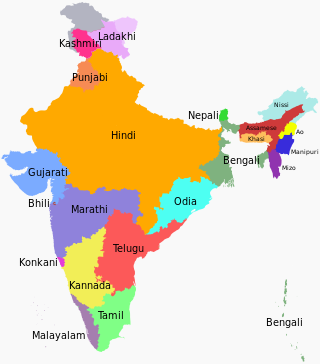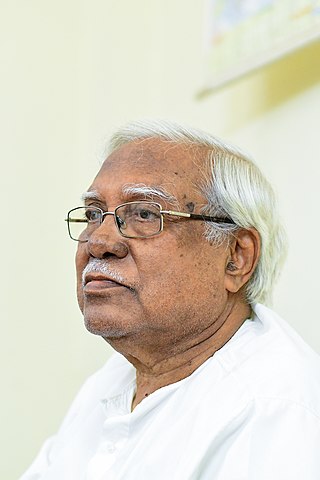Related Research Articles

Modern Standard Hindi, commonly referred to as Hindi, is an Indo-Aryan language spoken chiefly in North India, and serves as the lingua franca of the Hindi Belt region encompassing parts of northern, central, eastern, and western India. Hindi has been described as a standardised and Sanskritised register of the Hindustani language, which itself is based primarily on the Khariboli dialect of Delhi and neighbouring areas of North India. Hindi, written in the Devanagari script, is one of the two official languages of the Government of India, along with English. It is an official language in nine states and three union territories and an additional official language in three other states. Hindi is also one of the 22 scheduled languages of the Republic of India.

Haryana is an Indian state located in the northern part of the country. It was carved out of the former state of East Punjab on 1 November 1966 on a linguistic basis. It is ranked 21st in terms of area, with less than 1.4% of India's land area. The state capital is Chandigarh, which it shares with the neighbouring state of Punjab; and the most populous city is Faridabad, which is a part of the National Capital Region. The city of Gurgaon is among India's largest financial and technology hubs. Haryana has 6 administrative divisions, 22 districts, 72 sub-divisions, 93 revenue tehsils, 50 sub-tehsils, 140 community development blocks, 154 cities and towns, 7,356 villages, and 6,222 villages panchayats.

India, officially the Republic of India, is a country in South Asia. It is the seventh-largest country by area; the most populous country as of June 2023; and from the time of its independence in 1947, the world's most populous democracy. Bounded by the Indian Ocean on the south, the Arabian Sea on the southwest, and the Bay of Bengal on the southeast, it shares land borders with Pakistan to the west; China, Nepal, and Bhutan to the north; and Bangladesh and Myanmar to the east. In the Indian Ocean, India is in the vicinity of Sri Lanka and the Maldives; its Andaman and Nicobar Islands share a maritime border with Thailand, Myanmar, and Indonesia.

Sanskrit is a classical language belonging to the Indo-Aryan branch of the Indo-European languages. It arose in South Asia after its predecessor languages had diffused there from the northwest in the late Bronze Age. Sanskrit is the sacred language of Hinduism, the language of classical Hindu philosophy, and of historical texts of Buddhism and Jainism. It was a link language in ancient and medieval South Asia, and upon transmission of Hindu and Buddhist culture to Southeast Asia, East Asia and Central Asia in the early medieval era, it became a language of religion and high culture, and of the political elites in some of these regions. As a result, Sanskrit had a lasting effect on the languages of South Asia, Southeast Asia and East Asia, especially in their formal and learned vocabularies.

The Indo-Aryan languages are a branch of the Indo-Iranian languages in the Indo-European language family. As of the early 21st century, they have more than 800 million speakers, primarily concentrated in India, Pakistan, Sri Lanka, Bangladesh, Nepal and Maldives. Moreover, apart from the Indian subcontinent, large immigrant and expatriate Indo-Aryan–speaking communities live in Northwestern Europe, Western Asia, North America, the Caribbean, Southeast Africa, Polynesia and Australia, along with several million speakers of Romani languages primarily concentrated in Southeastern Europe. There are over 200 known Indo-Aryan languages.

Languages spoken in the Republic of India belong to several language families, the major ones being the Indo-Aryan languages spoken by 78.05% of Indians and the Dravidian languages spoken by 19.64% of Indians; both families together are sometimes known as Indic languages. Languages spoken by the remaining 2.31% of the population belong to the Austroasiatic, Sino–Tibetan, Tai–Kadai, and a few other minor language families and isolates. According to the People's Linguistic Survey of India, India has the second highest number of languages (780), after Papua New Guinea (840). Ethnologue lists a lower number of 456.

There is no national language in the Republic of India. However, article 343(1) of the Indian constitution specifically mentions that "The official language of the Union shall be Hindi in Devanagari script. The form of numerals to be used for the official purposes of the Union shall be the international form of Indian numerals," while article 343(2) allowed for the continuation of English as an official language for another 15 years and 343(3) gave the parliament the power to provide for the use of English language after this period. The clause 3 of the Official Languages Act, 1963 allows for the continued use of English language for official purposes of the Union government and for parliamentary business. Hence Indian English and Modern Standard Hindi are the Official Languages of the Government of India.

The Bhil languages are a group of Indo-Aryan languages spoken by around 10.4 million Bhils in western and central India as of 2011. They constitute the primary languages of the southern Aravalli Range in Rajasthan and the western Satpura Range in Madhya Pradesh, northwestern Maharashtra, and southern Gujarat. According to the 52nd report of the commissioner for linguistic minorities in India, Ministry of Minority Affairs, Bhili is the most commonly spoken language of the district of Dadra and Nagar Haveli constituting 40.42% of its total population. Bhili speakers are also significant in the states of Gujarat (4.75%), Madhya Pradesh (4.93%) and Rajasthan (4.60%).

Sansi are a formerly nomadic people from India that were classified as a criminal tribe in the 19th century by the British during the Raj period. They were stealing food supply from British Government. They claims to be Rajput descent. There were two distinct offshoots of the tribe: the first was a vagrant community connected to the Jat tribes of Central Punjab; the second was an agricultural Jat clan found in Sahiwal, Amritsar and Gujranwala.

Hannan Mollah is an Indian communist politician and a senior leader of the All India Kisan Sabha. He was the member of Indian parliament and elected as the Lok Sabha for eight times from constituency of Uluberia in Howrah district of West Bengal, mollah is the member of Politburo of the Communist Party of India (Marxist).

Sandwip is an upazila of Chattogram District in Chattogram Division, Bangladesh. It encompasses the islands of Sandwip and Urir Char.

Bauria is an extinct genus of the suborder Therocephalia that existed during the Early and Middle Triassic period, around 246-251 million years ago. It belonged to the family Bauriidae. Bauria was probably a herbivore or omnivore. It lived in South Africa, specifically in the Burgersdorp Formation in South Africa.

Microgomphodon is an extinct genus of therocephalian therapsid from the Middle Triassic of South Africa and Namibia. Currently only one species of Microgomphodon, M. oligocynus, is recognized. With fossils present in the Cynognathus Assemblage Zone (CAZ) of the Burgersdorp Formation in South Africa and Omingonde Formation of Namibia and ranging in age from late Olenekian to Anisian, it is one of the most geographically and temporally widespread therocephalian species. Moreover, its occurrence in the upper Omigonde Formation of Namibia makes Microgomphodon the latest-surviving therocephalian. Microgomphodon is a member of the family Bauriidae and a close relative of Bauria, another South African bauriid from the CAZ. Like other bauriids, it possesses several mammal-like features such as a secondary palate and broad, molar-like postcanine teeth, all of which evolved independently from mammals.

The 2011 census of India or the 15th Indian census was conducted in two phases, house listing and population enumeration. The House listing phase began on 1 April 2010 and involved the collection of information about all buildings. Information for National Population Register (NPR) was also collected in the first phase, which will be used to issue a 12-digit unique identification number to all registered Indian residents by Unique Identification Authority of India. The second population enumeration phase was conducted between 9 and 28 February 2011. Census has been conducted in India since 1872 and 2011 marks the first time biometric information was collected. According to the provisional reports released on 31 March 2011, the Indian population increased to 1.21 billion with a decadal growth of 17.70%. Adult literacy rate increased to 74.04% with a decadal growth of 9.21%. The motto of the census was Our Census, Our Future.
Vaghri (Bavri) is an Indo Aryan language of Pakistan. Vaghri, Wagdi, and Bauria are variants of the same name. It is not clear how many languages they are.

Udta Punjab is a 2016 Indian Hindi-language crime drama film written and directed by Abhishek Chaubey, co-written by Sudip Sharma, and produced by Shobha Kapoor, Ekta Kapoor, Sameer Nair and Aman Gill under Balaji Motion Pictures in association with Anurag Kashyap, Vikas Bahl and Vikramaditya Motwane under Phantom Films. Loosely based on and revolving around the drug abuse by the youth population in the Indian state of Punjab and the various conspiracies surrounding it, the film stars an ensemble cast of Shahid Kapoor, Alia Bhatt, Kareena Kapoor Khan and Diljit Dosanjh.
Kharagpur railway division is one of the four railway divisions under South Eastern Railway zone of Indian Railways. This railway division was formed on 14 April 1952 and its headquarters are located at Kharagpur in the state of West Bengal of India.
The South Eastern Line of Kolkata Suburban Railway is a suburban railway line serving Kolkata, West Bengal, India. It consists of 37 stations from Howrah Junction to Midnapore. The entire line is at grade level. It has section of triple track starting from Howrah Junction and ends at Midnapore, Amta, Haldia and Digha stations in West Bengal.
Bauria may refer to:

The Bauria railway station serves Bauria, Howrah district, in the Indian state of West Bengal. It is situated on the Howrah–Kharagpur line, at a distance of 24 km (15 mi) from the terminus of Howrah Station.
References
- ↑ "Statement 1: Abstract of speakers' strength of languages and mother tongues - 2011". www.censusindia.gov.in. Office of the Registrar General & Census Commissioner, India. Retrieved 7 July 2018.
- ↑ "Kurux". Ethnologue. Retrieved 11 July 2018.